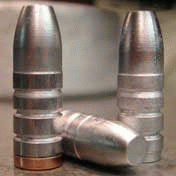

 The Accurate Reloading Forums
The Accurate Reloading Forums  THE ACCURATE RELOADING.COM FORUMS
THE ACCURATE RELOADING.COM FORUMS  Guns, Politics, Gunsmithing & Reloading
Guns, Politics, Gunsmithing & Reloading  Cast Bullets
Cast Bullets  Quick question about the color of a melt....
Quick question about the color of a melt....Go  | New  | Find  | Notify  | Tools  | Reply  |  |
| one of us |
When you melt a lot of wheelweights and while spooning the scum off the surface, if you see a strikingly beautiful colored surface underneath (primarily blue, but shifing rapidly), does that mean zinc (or other) contamimation? Haven't tried casting with it yet, but I seem to remember a past melt like that that did not cast at all well. | ||
|
| one of us |
Seem to remember a similar posting on another channel with the blue being credited to Bismuth, which won't hurt anything. I always melt the ww alloy and flux thoroughly just after it melts and isn't up to much of a temp. Read since that such a routine allows some of the zinc to be taken out in a pre-melt form. How accurate that is I dunno. Then I get it up to temp and reflux and pour ingots... as one of the guys on Shooters said "to ingot-tize"... which I'm sure is in the dictionary.... | |||
|
one of us |
While we're talking about this, can someone explain to me just what's actually happening with zinc-contaminated metal to make the boolits cast badly? And how come it doesn't make the wheelweights cast badly? Or are there separate wheelweights made out of just zinc alloy that only mix in with the lead alloy ones when we melt them? | |||
|
| one of us |
I don't know if there is more to it, but Zinc has a higher melting point than lead or tin. I had an ingot of what I thought was tin when I first started casting. It was hard and shiny like tin and weighed about the same. But it wasn't. The stuff melted, but just sluggishly in my melter. I tried to cast with it and just about ruined the pot (actually, it plugged up the bottom pour spout). I tried diluting it with pure lead and it ruined that, too. I finally threw it all out and spent a LONG time cleaning, scraping, and recleaning the pot before it would work again. Unfortunately, no European cars can use lead wheel balance weights anymore (for the last year or two, but some changed over several years ago). Most have gone to zinc. You are bound to get some in a bucket of wheelweights anymore. | |||
|
| one of us |
Quote: Zinc just isn't compatible with a lead alloy. Metalurgy manuals state .01% can make a mixture cast poorly and the bullets will crumble over time. | |||
|
| new member |
One more thing while we are on this subject. Whenever I have first melted my ww and removed the clips, there is a lot of crap including dirt, etc floating on top. It seems like I should remove all of the floating stuff at that point, but I always have the feeling that some of that material that looks like oxidized lead might be some of the other metals that I want to keep. Is it, or is it just oxidized garbage that needs to be removed? Docjones | |||
|
| one of us |
Doc, flux it good with wax or some other flux and stir it in good, then remove the clips. Most of my lead has a blue color too and I was told pure lead will show a little blue. I think it depends a lot on temperature as to what the surface looks like. I never worry about it because the boolits come out good. | |||
|
| one of us |
While we're talking about this, can someone explain to me just what's actually happening with zinc-contaminated metal to make the boolits cast badly? Some metals are soluble in others. We put them in a pot, or in a furnace, heat them until liquidification. When cooling them, two things could happend. BOTH METALS BECOME IN AN HOMOGENEOUS SOLID. Then, it is said both metals are miscible, soluble, both metals are now a soluble solution which has different characteristics from the two primary metals.(hardness, strenght,ductility,etc) The good guys of the movie   - Tin (Sn) is soluble in cooper(Cu), soluble solution is called bronze. -Zinc (Zn) is soluble in cooper(Cu), soluble solution is brass. -Carbon (C) is soluble in iron (Fe). Soluble solutions containing from O,1%C until 1.7%C are called steel. For higher carbon percentages, from 2%C until 4,5%C,they are called cast iron. -Lead(PB), Antimony(Sb) and Tin (Sn) makes several soluble solutions we know very well . Now the villian of this movie comes in scene.   BOTH METALS DOES NOT REMAIN SOLUBLE AT ROOM TEMPERATURE Zinc (Zn) is soluble in lead (Pb) until 0,5%, so,higher percentages of Zinc remains separated from lead when solidifying. As 05% Zn is a very low level, it does not change the characteristics of the alloy, we said they are not soluble,inmiscible,(we may add: for usefull applications) Now the leading man of the movie,who helps us against the bad guy   Mr.Dennis Marshall,who explains us, profesionally, metallurgy of Zinc/Lead in Lyman Cast Bullet Handbook, Third Edition,on page 44,Fig 1 and Fig 4. Metallurgy of molten lead alloys is a great chapter. Thanks Mr.Marshall for this article. Hope this helps BA Shooter | |||
|
one of us |
Thanks, BA, but that can't be the full explanation. Antimony's insoluble in lead at room temperature, but works fine. The problem's got to be with the viscosity or the wetting characteristics of the molten alloy on surfaces of the metals used for bullet moulds, and/or the surface tension of the molten alloy. The reports of bad bullets with zinc-contaminated alloy mention that it won't fill out right in moulds, and that occurs before the liquid metal solidifies. I've been doing a lot of Googling around on this question and turned up lots of cool info on lead alloys, but nothing that specifically addresses what the problem with zinc in lead is from a technical standpoint. But I did learn that the naturally occurring zinc in galena is removed from the smelted lead by skimming it off in the dross on top of the molten lead. I think this is done at a temperature where the lead is barely molten and the zinc tends to precipitate out. Which, come to think of it, probably answers my question. The zinc is crystallizing out while the lead is still liquid. Zinc floats in lead and would form inhomogeneities in the solidifying bullet. Antimony doesn't become supersaturated until the already solid alloy has cooled down well below the melting point. What we're doing with water quenching is chilling the alloy while the antimony's still in solid solution, following which as it ages the antimony precipitates in a much finer grain structure than is formed during slow air cooling. | |||
|
one of us |
I need to hunt up that Dennis Marshall article. The Lyman Cast Bullet Handbook I have is the first edition. | |||
|
| one of us |
Zinc contamination changes the surface tension of the molten alloy. Beyond the simple blue colored surface, you can also spot or earmark zinc contaminated metal by the ropy or stringly flow from a bottom-pour pot and from the silver "sticky" or "slimy" looking residue left on the top of your sprue plate. The blue is just a God-given alarm sounding that you got the stuff in your metal. The changing of the surface tension is what affects castability. Down inside your cavity, the increased surface tension causes rounded edges and incomplete fill in the finer features such as shallow small crimp grooves, etc. Your slugs sort of look like they were "remelted" in the worst cases when they drop out of the mold. Casting hotter and faster (frosty hot) can help this situation, but will not completely overcome it. The unamalgamated (unalloyed) large amounts of zinc that you accidentally stirred into your bulk alloy can be left to sit molten for an hour with a gentile spoon top scraping action removing the blue scum every 15-20 minutes, but this will NOT remove the half percent that does go into full solution and becomes bonded to the WW alloy. =================================================== This is what you have to do to NOT LET ZINC screw up your melts. YOU MUST KEEP THE LITTLE SUCKERS OUT OF YOUR MELT !!! Hand sort your WWs. Lay aside anything that seems light for its size (your fingers and eyes CAN instantly spot something that only weights 60% of what all the rest of them just did). When you melt, do it by adding one layer of WWs to the molten pool at a time. If you start to get a "zinc blob" forming immediately take a solid bottom spoon and get it out of there ASAP, taking a little good lead with it if you have to. It is like cutting out cancer -- get it all. DO NOT STIR YOUR METAL UNTIL YOU EYEBALL VERIFY YOU GOT NO BLOBS OF "UNKNOWN STUFF" IN THAT LAYER AND YOU GOT NO "BLUE SPOT" ON THE SURFACE. What you are doing here is KEEPING ALERT, banking off the fact that zinc melts slower than WWs and at a slightly higher temperature. It has a mushy transition stage (the blob) and it is a 40% lighter metal and will float that mushy blob right up there on the top of the molten pool for the big solid bottom spoon to pick it up. Lastly, if you see a lot of blue -- you are simply screwed for using that metal for fine bullet casting. Cast sinkers out of it. Give it away to somebody you don't like. I used up a pot of contaminated metal once casting crude plinker rounds for kids to shoot up, it is the only good use I have ever found for zinc contaminated metal. BTW, the least tiny bit of lead used to cause the old 1960's-1970's zinc "wonder bullets" to crumble over time. Not the other way around. Zinc gets into our cast stuff in small sub-1% amounts all the time and I have never heard of any of our cast lead slugs "crumbling" because of it. Heck, from how bitchy they actually cast for me about 5% of my historical melts may have had a mild case of the "zinc flu" to them. Oldfeller | |||
|
one of us |
Thanks for the info and tips, Oldfeller! | |||
|
| Powered by Social Strata |
| Please Wait. Your request is being processed... |
|
 The Accurate Reloading Forums
The Accurate Reloading Forums  THE ACCURATE RELOADING.COM FORUMS
THE ACCURATE RELOADING.COM FORUMS  Guns, Politics, Gunsmithing & Reloading
Guns, Politics, Gunsmithing & Reloading  Cast Bullets
Cast Bullets  Quick question about the color of a melt....
Quick question about the color of a melt....

Visit our on-line store for AR Memorabilia

